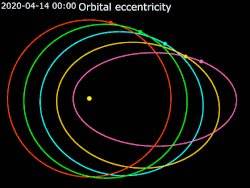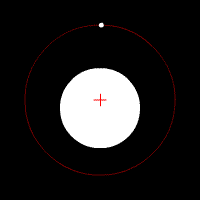
A | B | C | D | E | F | G | H | CH | I | J | K | L | M | N | O | P | Q | R | S | T | U | V | W | X | Y | Z | 0 | 1 | 2 | 3 | 4 | 5 | 6 | 7 | 8 | 9
This article includes a list of references, related reading, or external links, but its sources remain unclear because it lacks inline citations. (January 2021) |

0.0 · 0.2 · 0.4 · 0.6 · 0.8




| Part of a series on |
| Astrodynamics |
|---|
In astrodynamics or celestial mechanics, an elliptic orbit or elliptical orbit is a Kepler orbit with an eccentricity of less than 1; this includes the special case of a circular orbit, with eccentricity equal to 0. In a stricter sense, it is a Kepler orbit with the eccentricity greater than 0 and less than 1 (thus excluding the circular orbit). In a wider sense, it is a Kepler orbit with negative energy. This includes the radial elliptic orbit, with eccentricity equal to 1.
In a gravitational two-body problem with negative energy, both bodies follow similar elliptic orbits with the same orbital period around their common barycenter. Also the relative position of one body with respect to the other follows an elliptic orbit.
Examples of elliptic orbits include Hohmann transfer orbits, Molniya orbits, and tundra orbits.
Velocity
Under standard assumptions, no other forces acting except two spherically symmetrical bodies m1 and m2,[1] the orbital speed () of one body traveling along an elliptic orbit can be computed from the vis-viva equation as:[2]
where:
- is the standard gravitational parameter, G(m1+m2), often expressed as GM when one body is much larger than the other.
- is the distance between the orbiting body and center of mass.
- is the length of the semi-major axis.
The velocity equation for a hyperbolic trajectory has either + , or it is the same with the convention that in that case a is negative.
Orbital period
Under standard assumptions the orbital period () of a body travelling along an elliptic orbit can be computed as:[3]
where:
- is the standard gravitational parameter.
- is the length of the semi-major axis.
Conclusions:
- The orbital period is equal to that for a circular orbit with the orbital radius equal to the semi-major axis (),
- For a given semi-major axis the orbital period does not depend on the eccentricity (See also: Kepler's third law).
Energy
Under standard assumptions, the specific orbital energy () of an elliptic orbit is negative and the orbital energy conservation equation (the Vis-viva equation) for this orbit can take the form:[4]
where:
- is the orbital speed of the orbiting body,
- is the distance of the orbiting body from the central body,
- is the length of the semi-major axis,
- is the standard gravitational parameter.
Conclusions:
- For a given semi-major axis the specific orbital energy is independent of the eccentricity.
Using the virial theorem to find:
- the time-average of the specific potential energy is equal to −2ε
- the time-average of r−1 is a−1
- the time-average of the specific kinetic energy is equal to ε
Energy in terms of semi major axis
It can be helpful to know the energy in terms of the semi major axis (and the involved masses). The total energy of the orbit is given by
- ,
where a is the semi major axis.
Derivation
Since gravity is a central force, the angular momentum is constant:
At the closest and furthest approaches, the angular momentum is perpendicular to the distance from the mass orbited, therefore:
- .
The total energy of the orbit is given by[5]
- .
Substituting for v, the equation becomes
- .
This is true for r being the closest / furthest distance so two simultaneous equations are made, which when solved for E:
Since and , where epsilon is the eccentricity of the orbit, the stated result is reached.
Flight path angle
The flight path angle is the angle between the orbiting body's velocity vector (equal to the vector tangent to the instantaneous orbit) and the local horizontal. Under standard assumptions of the conservation of angular momentum the flight path angle satisfies the equation:[6]
where:
- is the specific relative angular momentum of the orbit,
- is the orbital speed of the orbiting body,
- is the radial distance of the orbiting body from the central body,
- is the flight path angle
Antropológia
Aplikované vedy
Bibliometria
Dejiny vedy
Encyklopédie
Filozofia vedy
Forenzné vedy
Humanitné vedy
Knižničná veda
Kryogenika
Kryptológia
Kulturológia
Literárna veda
Medzidisciplinárne oblasti
Metódy kvantitatívnej analýzy
Metavedy
Metodika
Text je dostupný za podmienok Creative
Commons Attribution/Share-Alike License 3.0 Unported; prípadne za ďalších
podmienok.
Podrobnejšie informácie nájdete na stránke Podmienky
použitia.
www.astronomia.sk | www.biologia.sk | www.botanika.sk | www.dejiny.sk | www.economy.sk | www.elektrotechnika.sk | www.estetika.sk | www.farmakologia.sk | www.filozofia.sk | Fyzika | www.futurologia.sk | www.genetika.sk | www.chemia.sk | www.lingvistika.sk | www.politologia.sk | www.psychologia.sk | www.sexuologia.sk | www.sociologia.sk | www.veda.sk I www.zoologia.sk
























